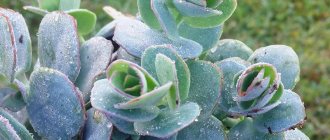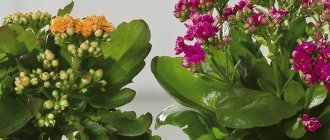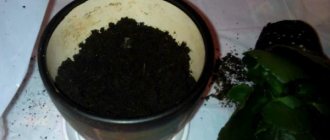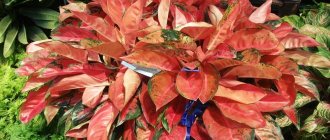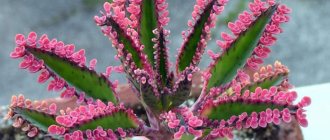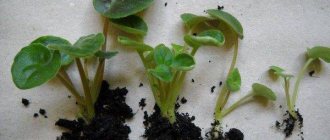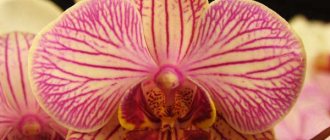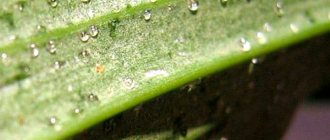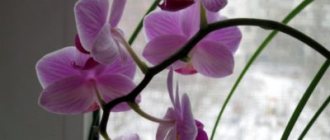The exotic plant Kalanchoe blossfeldiana belongs to the Crassulaceae family. The birthplace of the flower is Madagascar. Thanks to the famous German botanist Robert Blossfeld, the flower got its name. It was Blossfeld who first introduced this type of Kalanchoe to European society at the beginning of the 20th century.
Briefly about care
| Type of agricultural operation for caring for Kalanchoe Blossfeld | Description of conditions and actions |
| Watering and air humidity | spring and autumn - once every 2 weeks, summer - once a week, winter - once every 3 weeks; You can wipe the leaves from dust |
| Lighting organization | bright diffused sunlight; In winter, lighting may be required; In summer, shading is needed |
| Maintaining a rest period | no rest period |
| Creating temperature conditions | the air temperature should not be higher than 25 °C and lower than 10 °C |
| Trimming | After the succulent has faded, it is necessary to remove the flower stalks |
| Making soil mixture | the substrate should consist of sand and compost soil |
| Fertilizer application | in the summer, the flower must be fertilized several times a month |
| Transfer | a young plant must be replanted once a year, and adult specimens - once every few years |
| Chemical treatment | insecticides for mealybugs, aphids and scale insects; fungicides against mold and powdery mildew |
Flower diseases and treatment methods
The leaves and roots of Kalanchoe Blossfeld are sensitive to fungal infections, overheating, drying out, and pest attacks. The loss of leaves and decorativeness of the plant is what I got already in the first year of flower care. There are two ways out - radical pruning with fungicide treatment or cutting and rooting of cuttings, but after treatment with an antifungal drug.
As a rule, diseases, especially stem and root rot, appear as a result of excessive watering. While there is no infection, too much moisture is manifested by the growth of shoots with small leaves. Then the leaf blades turn yellow, curl and dry. This may already be a symptom of a fungal disease.
The best thing to do is to transplant the Kalanchoe into a loose, low-nutrient, well-drained substrate and do not water it for 2 weeks.
Secret No. 9. After pruning and replanting, the plant recovers well. Therefore, when saving a flower, you need to ruthlessly remove the damaged parts and replant them in a fresh substrate.
Description of the plant
The perennial succulent Kalanchoe Blossfeld is the most popular species. Before the New Year holidays, on St. Valentine and March 8, the plant can be seen in a large assortment on the shelves of flower shops. It is usually grown and delivered from Holland.
The bush has a squat rosette of dense and rather large leaves with a combed edge. The leaves are able to retain moisture for a long time. Inflorescences of various flowers are 1-2 cm in size.
This species does not have medicinal properties. Only two types of Kalanchoe can be considered medicinal: Cirrus and Kalanchoe Daigremontiana.
The Blossfeld succulent is popularly called the “Christmas flower” because the plant begins to bloom in the winter season. In addition, some nationalities give a pot of an amazing plant as a gift for Christmas.
Photo of Kalanchoe Blossfeld:
Trimming
From the store we bring a pot with a small bush, above which rises a “cap” of bright flowers. Subsequently, the plant dies or stretches out and does not set buds. Conditions in greenhouses and conservatories differ from those at home. In addition, from the moment of sowing until sale, plants are “pumped” with biostimulants, inhibitors, and fertilizers.
After some time in the house, Blossfeld's Kalanchoe returns to its natural "flaming Katie" growth pattern. The bush becomes less compact, loose, and produces fewer flower clusters. This February, I cut off a “fat” shoot that didn’t even have a hint of buds.
Secret No. 7. The plant needs annual pruning. During the growing season, carefully pinch off the tops. After flowering, prune heavily, leaving stumps with 1–2 pairs of leaves. We root the cut shoots for propagation.
What is important to know before purchasing
To avoid unpleasant surprises, pay attention to the characteristics of the plant given in the table below.
| Mature plant size | no more than 30 cm. common type |
| Lifespan | up to 10 years, but after 6 years it loses its decorative effect |
| Bloom | flowering up to 3 months; blooms in red, pink, orange, salmon, yellow, cream and white flowers |
| Aroma | weak, barely perceptible |
| Safety | poisonous for consumption by pets and children |
| Difficulty of care | unpretentious |
| Uniqueness | |
| Where can I buy |
|
How to distinguish Blossfeld from other species
Many people cannot distinguish Kalanchoe Blossfeld from Kalanchoe Kalandiva, Rosalina, Grandiva. Everything is very simple - Blossfeld is the progenitor of the listed varieties. Therefore, they can all be classified as the Blosfeld Kalanchoe species.
For other types of Kalanchoe, read the article at the link.
Table of differences between Blossfeld varieties
| Kalanchoe variety Blossfeld | Distinctive feature |
| Rosaline | The most compact bush with small flowers |
| Kalandiva | Lush blooms reminiscent of rose buds, flowers have many tiers of petals |
| Grandiva | The largest flowers with many petals |
Photos of the given varieties:
Kalanchoe Blossfeld variety Rosalina (Kalanchoe Rosalina Don Amador)
Kalanchoe Blossfeld variety Grandiva (Kalanchoe Grandiva pink)
Kalanchoe Blossfeld variety Kalanchoe Calandiva
Medicinal properties of Kalanchoe Blossfeld
This succulent attracts many gardeners not only with its luxurious flowering, but also with the possibility of using it for medicinal purposes. The juice extracted from the leaves is used in folk medicine and cosmetology. The list of medicinal effects of this type of plant includes:
- treatment of damage to the skin and mucous membranes, including wounds, birth defects and cracks;
- relieving inflammation of the oral mucosa;
- skin hydration;
- treatment of eye inflammation;
- strengthening the protective properties of the skin during dryness and frostbite;
- use as an adjuvant therapy for pathologies of the gastrointestinal tract, liver and infectious lesions;
- elimination of symptoms of allergic cough;
- cosmetic effect on skin with formations in the form of acne and warts.
As can be seen from this list, this plant is widely used in folk medicine.
The article uses materials from the site llifle.com
Watering
According to experienced gardeners, this succulent is an unpretentious plant that is easy to grow. However, caring for Kalanchoe Blossfeld at home after purchasing it in a store can be problematic for a beginner. This is because the new owner, out of ignorance and out of great love for the plant, can, for example, flood the flower, thinking that the poor thing was drying in the store, waiting for salvation. Learn simple rules for growing and caring so as not to harm the succulent from the first days.
Since the homeland of the exotic succulent is Madagascar, the plant is accustomed to dry air and rare precipitation. Frequent and abundant watering can harm Kalanchoe.
In summer, it is recommended to water the flower after the top layer of soil has completely dried. In winter, the amount of watering should be halved.
Attention! For watering you need to use soft water at room temperature. Cold or hard water is not suitable for irrigation. When watering, you need to make sure that water does not accumulate on the leaves. High humidity can cause mold or rot.
Illumination
Madagascar Kalanchoe loves bright and sunny light. The flower can be kept on the windowsill on the east or south-east side of the windows. During particularly hot days, the succulent should be shaded or placed in a dark place out of reach of the burning rays of the sun. Direct sunlight can cause the plant to burn - the leaves will turn yellow, curl, begin to dry out and fall off. In winter, the flower may not have enough daylight, so the lack of natural light can be compensated by using special lamps.
Advice! If your flowerpot is on the south side, pay attention to the leaves. As soon as a red edging appears on them, shade the plant. Thus, the flower signals that it has too much bright light.
Growing conditions
Kalanchoe has an amazing ability to adapt to almost any conditions. However, the plant will delight the owner with abundant and long-lasting flowering only if a few simple recommendations are followed.
Lighting
It is recommended to grow the crop in partial shade. The duration of daylight hours should be short (8-9 hours). In winter, Kalanchoe needs additional lighting. In summer and spring, on the contrary, it is covered with a cap made of dark-colored glass.
You can determine how comfortable the lighting is for a Kalanchoe by looking at its leaves. If they get a lot of light, the leaf blades begin to become covered with burn spots and turn red around the edges. If there is little light, the stems become weak, the inflorescences become sparse, and the leaves become smaller.
Temperature
The optimal temperature for Kalanchoe is considered to be from +18 to +25 degrees. The succulent reacts to the cold by going into hibernation. Reducing the temperature to +10 degrees is disastrous for him. If left in such conditions for a long time, the plant may even die. That is why special attention must be paid to the temperature regime in winter. Kalanchoe should not be kept in cold and damp rooms. Drafts are also contraindicated for him.
Planting container
The root system of Kalanchoe is compact, so you can choose a small container for planting the plant. However, there should still be enough space for roots. Both plastic and ceramic pot options are equally good. The main thing is that they have drainage holes.
The soil
It is important that the soil for growing Kalanchoe Blossfeld is well drained. Expanded clay or brick chips are most often used as drainage. The acidity of the soil should be weak or neutral (5–7 pH).
You can prepare the soil mixture yourself. To do this you need to use:
- turf land;
- deciduous soil;
- coarse sand;
- humus;
- peat.
Sand can be replaced with coconut fiber or chopped moss. It is necessary that the soil structure is loose. All components are taken in equal proportions. The mass is thoroughly mixed and then placed in planting containers. Commercial soil intended for succulent plants or cacti is also suitable.
Humidity and temperature
The succulent feels comfortable in both dry and humid air. It is necessary to spray the plant only on the driest and hottest days or when the Kalanchoe looks sick: the leaves have turned yellow and withered, and feel dry to the touch.
Periodically, you can wipe the sheet plates with a soft, damp cloth, sweeping away dust and dirt.
An exotic succulent will feel comfortable at almost any temperature. In summer, you need to make sure that the Christmas flower does not overheat; for this, the thermometer should not be above 25 °C. In cold winter, the temperature in the room should not be below 10 °C.
Rest period
Kalanchoe does not tolerate temperatures below 14°C, so it overwinters indoors. The cold, cloudy season of the year is very necessary for short-day plants to flower. This year I noticed that the buds on the Kalanchoe appeared early, but were developing slowly. This is due to the fact that the winter is warm, sunny, and the apartment is warm.
I'm expecting the buds to open any day now. By the way, the leaves are so shiny that it hurts your eyes. However, I haven’t washed or sprayed them since the summer.
Bloom
When does Kalanchoe Blossfeld bloom? The succulent blooms in the winter season. The flowers are small and predominantly red. Although hybrid varieties have been bred that bloom with inflorescences of various colors: from soft pink and cream to rich orange and purple.
Home care for Kalanchoe Blossfeld should include pruning the plant. Pruning is needed after the succulent has finished flowering. Old peduncles and excess branches should be trimmed.
Popular varieties
How to prune Kalanchoe: examples of bush formation and further flower care
At the end of the last century, breeders in Denmark and Holland developed numerous varieties of Kalanchoe Blossfeld, differing from natural forms in the splendor of flowering and more compact crown sizes. Now you can buy a plant with flowers of white, orange, pink, yellow shades, and not only with simple corollas (4-8 petals), but also with double ones (up to 30 petals). A group of hybrids based on Kalanchoe Blossfeld received the common name Kalandiva and are characterized by a long flowering period (up to 6 months).
Variegata
The variety is distinguished by its special leaf color. They are lighter than usual, but are covered with chaotic spots and stripes of white, cream and pinkish tints. There may be a reddish border along the edge. Variegata blooms predominantly with red and coral flowers.
Kalanchoe blossfeldiana Variegata
Rosalind (Pink Flaming Katy)
Rosebud variety with a compact bush no more than 25 cm high and very large wide leaves. The corollas of flowers are double, terry. The petals on the face are brighter than on the back, painted in a delicate pink shade, darkening as they fully bloom. The usual flowering time is spring, but under optimal conditions it can produce flower stalks again several times a year.
Kalanchoe blossfeldiana Pink Flaming Katy
Kalandiva mini (Liliput)
Variety series obtained on the basis of the Kalandiva line. The flowers are numerous, double, painted in pink, white, yellow, and red shades. A distinctive feature is the maximum compactness of the bush. The height of the plant does not exceed 10-15 cm including peduncles.
Kalanchoe blossfeldiana Calandiva mini
Shell Pink
The plant is very popular. Its flower stalks are large corymbose caps of numerous buds (up to 60 on each). At first, the petals are painted in a simple white-green shade, but as they bloom they become soft pink with barely noticeable veins. Although each corolla has only 4 petals, the variety is not inferior in effectiveness to rosebud varieties.
Kalanchoe blossfeldiana Shell Pink
Grandiva
Variety series with large flowers up to 2 cm in diameter. The shades of the petals are very different: pink, purple, violet, orange, lilac. The leaves are large and form a cup, from which short thick peduncles crowned with unusually large double buds shoot upward.
Kalanchoe blossfeldiana Grandiva
Kalanchoe Blossfeldiana mix
Under this name, terry varieties belonging to the Kalandiva group are most often sold in retail chains. They come in a variety of shades: white, red, purple, orange, yellow, violet, etc. Every year new shades appear, obtained as a result of the hard work of breeders from large European nurseries.
Multi-colored Kalanchoe Blossfeld
Tom Thumb Tetra and Orange Triumph
Variety series, which is easily identified by its large crown (up to 30 cm in height) with large wide leaves, as well as by flowers with 4 petals, similar to small stars. It included specimens with red and orange flowers, formed on short succulent peduncles in the form of loose racemes or corymbose inflorescences. This variety is 100% suitable for indoor use; it is unpretentious and has increased immunity.
Kalanchoe Tom Thumb
Transplantation and soil
The best time for transplantation is spring.
It is recommended to replant young plants every year. Adult specimens - once every few years or as needed.
To replant, you will need a clay pot that will be slightly wider in diameter than the previous one. When replanting, you need to carefully examine the roots of the flower. If rotten, diseased or infected roots are identified, they must be separated from healthy ones. The plant needs to be replanted in a moist substrate.
For Kalanchoe Blossfeld, you can purchase a ready-made soil mixture at a flower shop, or make it yourself. The soil should consist of compost soil, sand and peat.
When transplanting or planting, you should not forget about the drainage layer, which will absorb excess moisture.
To prevent rotting, crushed charcoal can be added to the soil mixture.
Transplanting into another pot
Kalanchoe Blossfeld grows very quickly. Therefore, transplantation is an integral part of its care. Fortunately, this flower adapts quite quickly after transplantation to a new place of residence. The Kalanchoe root develops much faster than the stem system. To transplant it correctly, you need to follow the step-by-step instructions:
Pre-prepare a large pot with a drainage layer at the bottom.- Carefully remove the plant from the old pot without damaging the root.
- Place the Kalanchoe in a new flowerpot, adding fertilized soil to the bottom. In this case, you need to level the root system (this will ensure its uniform growth).
- Cover the soil in the pot with fertilized layers of soil. Compact each layer a little.
- The replanting will be completed once the entire root remains underground.
- After this, moisten the soil a little. And wait for your treasure to delight you with its beauty again.
Kalanchoe Blossfeld is a very beautiful and unpretentious plant. Even an inexperienced gardener can easily grow it. This flower is great for a cottage, apartment or house. It will help decorate any corner of the house and create comfort and a pleasant atmosphere in it. And thanks to its unpretentiousness in care, Kalanchoe is gaining more and more popularity in our country and every year it becomes a favorite in new families.
Reproduction
Any flower can reproduce. Kalanchoe Blossfeld is characterized by propagation by leaves, cuttings and seeds.
Leaf
A simple method of propagation is leaf propagation. For propagation, you will only need healthy leaves that are not affected by the disease. You need to carefully separate several leaves from the succulent and immerse them in bottles of water. After the leaves sprout roots, they can be planted in moist soil.
Separation of root suckers
After flowering is completed, the tip of the shoot is pinched to stimulate the development of offspring. As a result, young offspring appear near the mother flower. They are used for reproduction. After this, the offspring can be separated and planted in a pot with a sand-turf substrate (8 parts river sand, 2 parts sifted turf soil).
The offspring must reach 1/3 the length of the adult plant
Diseases
Many gardeners are interested in the question of how to care for Kalanchoe Blossfeld so that it is not affected by the disease? It is enough to observe temperature conditions, avoid excessive watering, and do not forget to feed and monitor the general condition of the plant.
A common flower disease is powdery mildew, which manifests itself as a white coating on the leaves of the plant. The disease appears when the succulent is watered abundantly or frequently.
Exposing the plant to damp conditions can lead to mold or rot.
Direct burning rays of the sun can also cause irreparable damage to the succulent. In case of burns, the flower will experience yellowing and curling of the leaves, and the leaf plates may dry out and fall off. If burns are detected on a succulent, it should be immediately sprayed with cool water and put in a dark place inaccessible to sunlight.
Pests
The most common pests for Kalanchoe Blossfeld are scale insects, aphids and mealybugs. Parasites nest in the roots and leaves of the plant and feed on plant sap. In such a neighborhood, the succulent will not be able to remain healthy and unharmed for a long time. Every day the plant will begin to wither; if measures are not taken, the Kalanchoe will die.
An effective method of controlling parasites is a soap solution. In severe cases of infection, you must resort to the use of insecticides.
A unique flower is Kalanchoe Blossfeld, named after the German breeder. The flower has an unusual appearance and delights others with its dense blooms. The peculiarity of the plant is that it blooms in the winter months, which is why Kalanchoe is called the Christmas flower. The succulent has healing properties and is used for wounds, burns, and cuts.
